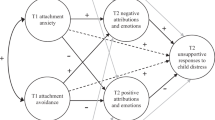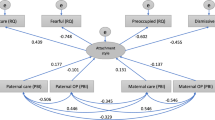Abstract
The present study aimed to examine parental psychological distress and confidence after an infant’s birth, when parenting an infant with a diagnosis of a congenital anomaly, and to understand the role of attachment representations on parental adjustment. Parents of infants with a congenital anomaly (44 couples) and parents of healthy infants (46 couples) completed measures of adult attachment representations and of psychological distress and parental confidence (one month after the infant’s birth). Results showed no group differences in psychological distress. Mothers in the clinical group presented lower confidence than mothers in the comparison group, while for fathers the inverse pattern was found, showing their involvement in the caretaking of the infant. Insecure attachment representations predicted parental psychological distress, and a moderator role of group was found only for fathers. These results highlight the role of secure attachment representations as an individual resource in stress-inducing situations.

Similar content being viewed by others
References
Aiken, L. S., & West, S. G. (1991). Multiple regression: Testing and interpreting interactions. Newbury Park, CA: Sage.
Aite, L., Trucchi, A., Nahom, A., Zaccara, A., Casaccia, G., & Bagolan, P. (2003). A challenging intervention with maternal anxiety: Babies requiring surgical correction of a congenital anomaly after missed prenatal diagnosis. Infant Mental Health Journal, 24, 571–579.
Belsky, J., Lang, M., & Huston, T. (1986). Sex typing and division of labor as determinants of marital change across the transition to parenthood. Journal of Personality and Social Psychology, 50, 517–522.
Berant, E., Mikulincer, M., & Florian, V. (2001). The association of mothers’ attachment style and their psychological reactions to the diagnosis of infant’s congenital heart disease. Journal of Social and Clinical Psychology, 20, 208–232.
Bifulco, A., Figueiredo, B., Guedeney, N., Gorman, L., Hayes, S., Muzik, M., et al. (2004). Maternal attachment style and depression associated with childbirth: Preliminary results from a European and US cross-cultural study. British Journal of Psychiatry, 184, s31–s37.
Bowlby, J. (1969). Attachment and loss: Attachment (Vol. 1). New York: Basic Books.
Brosig, C. L., Whitstone, B. N., Frommelt, M. A., Frisbee, S. J., & Leuthner, S. R. (2007). Psychological distress in parents of children with severe congenital heart disease: The impact of prenatal versus postnatal diagnosis. Journal of Perinatology, 27, 687–692.
Canavarro, M. C., Dias, P., & Lima, V. (2006). A avaliação da vinculação do adulto: Uma revisão crítica a propósito da aplicação da Adult Attachment Scale-R (AAS-R) na população portuguesa [The assessment of adult attachment: A critical review of the application of Adult Attachment Scale-R (AAS-R) in the Portuguese population]. Psicologia, 20, 155–187.
Carnevale, F., Alexander, E., Davis, M., Rennick, J., & Troini, R. (2006). Daily living with distress and enrichment: The moral experience of families with ventilator-assisted children at home. Pediatrics, 117, 48–60.
Collins, N. (2008). Adult Attachment Scale instrument and scoring. Retrieved January 12, 2012, from Open Psych Assessment: http://www.openpsychassessment.org/standard-measures/general-social-psychology-instruments/nancy-collins-adult-attachment-scale/
Cowan, C. P., & Cowan, P. A. (1988). Changes in marriage during the transition to parenthood: Must we blame the baby? In G. Y. Michaels & W. A. Goldberg (Eds.), The transition to parenthood: Current theory and research (pp. 114–154). Cambridge: Cambridge University Press.
Cowan, C. P., & Cowan, P. A. (1992). When partners become parents: The big life change for couples. New York: Basic Books.
Cox, M. J., & Paley, B. (2003). Understanding families as systems. Current Directions in Psychological Science, 12, 193–196.
Crncec, R., Barnett, B., & Matthey, S. (2010). Review of scales of parenting confidence. Journal of Nursing Measurement, 18, 210–240.
Crowley, L. (2010). An introduction to human disease: Pathology and pathophysiology correlations (8th ed.). Sudbury: Jones and Bartlett Publishers.
Cutrona, C., & Troutman, B. (1986). Social support, infant temperament, and parenting self-efficacy: A mediational model of postpartum depression. Child Development, 57, 1507–1518.
Demo, D., & Cox, M. J. (2000). Families with young children: A review of research in the 1990 s. Journal of Marriage and the Family, 62, 867–895.
Derogatis, L. R. (2000). The Brief Symptom Inventory-18 (BSI-18): Administration, scoring and procedures manual. Minneapolis, MN: National Computer Systems.
Faul, F., Erdfelder, E., Lang, A. G., & Buchner, A. (2007). G*Power3: A flexible statistical power analysis program for the social, behavioral, and biomedical sciences. Behavior Research Methods, 39, 175–191.
Feeney, J. (2003). Adult attachment, involvement in infant care, and adjustment to new parenthood. Journal of Systemic Therapies, 22, 16–30.
Feeney, J., Alexander, R., Noller, P., & Hohaus, L. (2003). Attachment insecurity, depression, and the transition to parenthood. Personal Relationships, 10, 475–493.
Fonseca, A., Nazaré, B., & Canavarro, M. C. (2012). Parental psychological distress and quality of life after a prenatal or postnatal diagnosis of congenital anomaly: A controlled comparison study with parents of healthy infants. Disability and Health Journal, 5, 67–74.
Freeman, C. (2006). Relative contributions of mastery, maternal affective states, and childhood difficulty to maternal self-efficacy. Unpublished doctoral dissertation, University of Nevada, Reno, USA.
Gray, D. E. (2003). Gender and coping: The parents of children with high functioning autism. Social Science and Medicine, 56, 631–642.
Griffin, D., & Bartholomew, K. (1994). Models of the self and other: Fundamental dimensions underlying measures of adult attachment. Journal of Personality and Social Psychology, 67, 430–445.
Hess, C., Teti, D., & Hussey-Gardner, B. (2004). Self-efficacy and parenting of high-risk infants: The moderating role of parent knowledge of infant development. Applied Developmental Psychology, 25, 423–437.
Hudson, D., Elek, S., & Fleck, M. (2001). First-time mothers’ and fathers’ transition to parenthood: Infant care self-efficacy, parenting satisfaction, and infant sex. Issues in Comprehensive Pediatric Nursing, 24, 31–43.
Hunfeld, J., Tempels, A., Passchier, J., Hazebroek, F., & Tibboel, D. (1999). Parental burden and grief one year after the birth of a child with a congenital anomaly. Journal of Pediatric Psychology, 24, 631–642.
Jones, T., & Prinz, R. (2005). Potential roles of parental self-efficacy in parent and child adjustment: A review. Clinical Psychology Review, 25, 341–363.
Jose, P. (2008). ModGraph-I: A programme to compute cell means for the graphical display of moderational analyses: The internet version, Version 2.0. Retrieved February 10, 2012, from http://www.victoria.ac.nz/psyc/staff/paul-josefiles/modgraph/modgraph.php
Katz-Wise, S., Priess, H., & Hyde, J. (2010). Gender-role attitudes and behavior across the transition to parenthood. Developmental Psychology, 46, 18–28.
Lalor, J., Begley, C., & Galavan, E. (2009). Recasting hope: A process of adaptation following fetal anomaly. Social Science and Medicine, 68, 462-472.
Leahy-Warren, P., & McCarthy, G. (2011). Maternal parental self-efficacy in the postpartum period. Midwifery, 27, 802–810.
Lopez, F., & Brennan, K. A. (2000). Dynamic processes underlying adult attachment organization: Toward an attachment theoretical perspective on the healthy and effective self. Journal of Counseling Psychology, 47, 283–300.
Mazer, P., Gischler, S. J., Koot, H. M., Tibboel, D., Dijk, M., Duivenvoorden, H. J., et al. (2008). Impact of a Child with Congenital Anomalies on Parents (ICCAP) questionnaire: a psychometric analysis. Health and Quality of Life Outcomes, 6, 102–110.
McMahon, C., Barnett, B., Kowalenko, N., & Tennant, C. (2005). Psychological factors associated with persistent postnatal depression: Past and current relationships, defence styles and the mediating role of insecure attachment style. Journal of Affective Disorders, 84, 15–24.
Mendes, D. (2007). Lived experience by first-time parents in the postpartum. Birth, 15, 119–125.
Mercer, R., & Ferketich, S. L. (1994). Predictors of maternal role competence by risk status. Nursing Research, 43, 38–43.
Messias, D., Gilliss, C., Sparacino, P., Tong, E., & Foote, D. (1995). Stories of transition: Parents recall the diagnosis of congenital heart defect. Family Systems Medicine, 13, 367–377.
Mikulincer, M., & Florian, V. (1995). Appraisal and coping with a real-life stressful situation: The contribution of attachment styles. Personality and Social Psychology Bulletin, 69, 1203–1215.
Mikulincer, M., & Florian, V. (1998). The relationship between adult attachment styles and emotional and cognitive reactions to stressful events. In J. A. Simpson & W. S. Rholes (Eds.), Attachment theory and close relationships (pp. 143–165). New York: Guilford.
Miles, M., Holditch-Davis, D., Burchinal, M., & Brunssen, S. (2011). Maternal role attainment with medically fragile infants: Part 1. Measurement and correlates during the first year of life. Research in Nursing & Health, 34, 20–34.
Monk, C., Leight, K., & Fang, Y. (2008). The relationship between women’s attachment style and perinatal mood disturbance: Implications for screening and treatment. Archives of Women’s Mental Health, 11, 117–129.
Nazaré, B., Fonseca, A., & Canavarro, M. C. (2011). Avaliação da confiança parental: Versão portuguesa do Maternal Confidence Questionnaire [The assessment of parental confidence: Portuguese version of the Maternal Confidence Questionnaire]. In A. S. Ferreira, A. Verhaeghe, D. R. Silva, L. S. Almeida, R. Lima & S. Fraga (Eds), Proceedings from the VIII Congresso Iberoamericano de Avaliação Psicológica/XV Conferência Internacional de Avaliação Psicológica: Formas e Contextos (pp. 1949-1960). Lisboa: Sociedade Portuguesa de Psicologia.
Pinelli, J., Saigal, S., Wu, Y. W., Cunningham, C., DiCenso, A., Steele, S., et al. (2008). Patterns of change in family functioning, resources, coping and parental depression in mothers and fathers of sick newborns over the first year of life. Journal of Neonatal Nursing, 14, 156–165.
Reece, S., & Harkless, G. (1998). Self-efficacy, stress, and parental adaptation: Applications to the care of childbearing families. Journal of Family Nursing, 4, 198–215.
Rholes, W. S., Simpson, J. A., Blakely, B., Lanigan, L., & Allen, E. (1997). Adult attachment styles, the desire to have children, and working models of parenthood. Journal of Personality, 65, 357–385.
Salonen, A., Kaunonen, M., Astedt-Kurki, P., Järvenpää, A.-L., Isoaho, H., & Tarkka, M.-T. (2009). Parenting self-efficacy after childbirth. Journal of Advanced Nursing, 65, 2324–2336.
Seligman, M., & Darling, R. (2007). Ordinary families, special children: A systems approach to childhood disability (3rd ed.). New York: The Guilford Press.
Simpson, J. A., Rholes, W. S., Campbell, L., Tran, S., & Wilson, C. (2003). Adult attachment, the transition to parenthood, and depressive symptoms. Journal of Personality and Social Psychology, 84, 1172–1187.
Skari, H., Malt, U., Bjornland, K., Egeland, T., Haugen, G., Skreden, M., et al. (2006). Prenatal diagnosis of congenital malformations and parental psychological distress: A prospective longitudinal cohort study. Prenatal Diagnosis, 26, 1001–1009.
Teti, D., & Gelfand, D. (1991). Behavioral competence among mothers of infants in the first year: The mediational role of maternal self-efficacy. Child Development, 62, 918–929.
Zahr, L. (1993). The confidence of Latina mothers in the care of their low birth weight infants. Research in Nursing and Health, 16, 335–342.
Acknowledgments
This study is part of the “Reproductive decisions and transition to parenthood after a pre- or postnatal diagnosis of congenital anomaly” research project, integrated in the Relationships, Development and Health Research Group of the R&D Unit Institute of Cognitive Psychology, Vocational and Social Development of the University of Coimbra (PEst-OE/PSI/UI0192/2011). Ana Fonseca and Bárbara Nazaré are supported by PhD Scholarships from the Portuguese Foundation for Science and Technology (SFRH/BD/47053/2008, SFRH/BD/43204/2008, respectively). The authors wish to thank the services that enabled the sample collection: Pediatric Cardiology Service of the Pediatric Hospital—Centro Hospitalar de Coimbra (parents of babies with congenital heart disease) and the Obstetrics and Neonatology Departments—Hospitais da Universidade de Coimbra (the remaining participants from the clinical and comparison groups).
Author information
Authors and Affiliations
Corresponding author
Rights and permissions
About this article
Cite this article
Fonseca, A., Nazaré, B. & Canavarro, M.C. Parental Psychological Distress and Confidence After an Infant’s Birth: The Role of Attachment Representations in Parents of Infants with Congenital Anomalies and Parents of Healthy Infants. J Clin Psychol Med Settings 20, 143–155 (2013). https://doi.org/10.1007/s10880-012-9329-9
Published:
Issue Date:
DOI: https://doi.org/10.1007/s10880-012-9329-9




